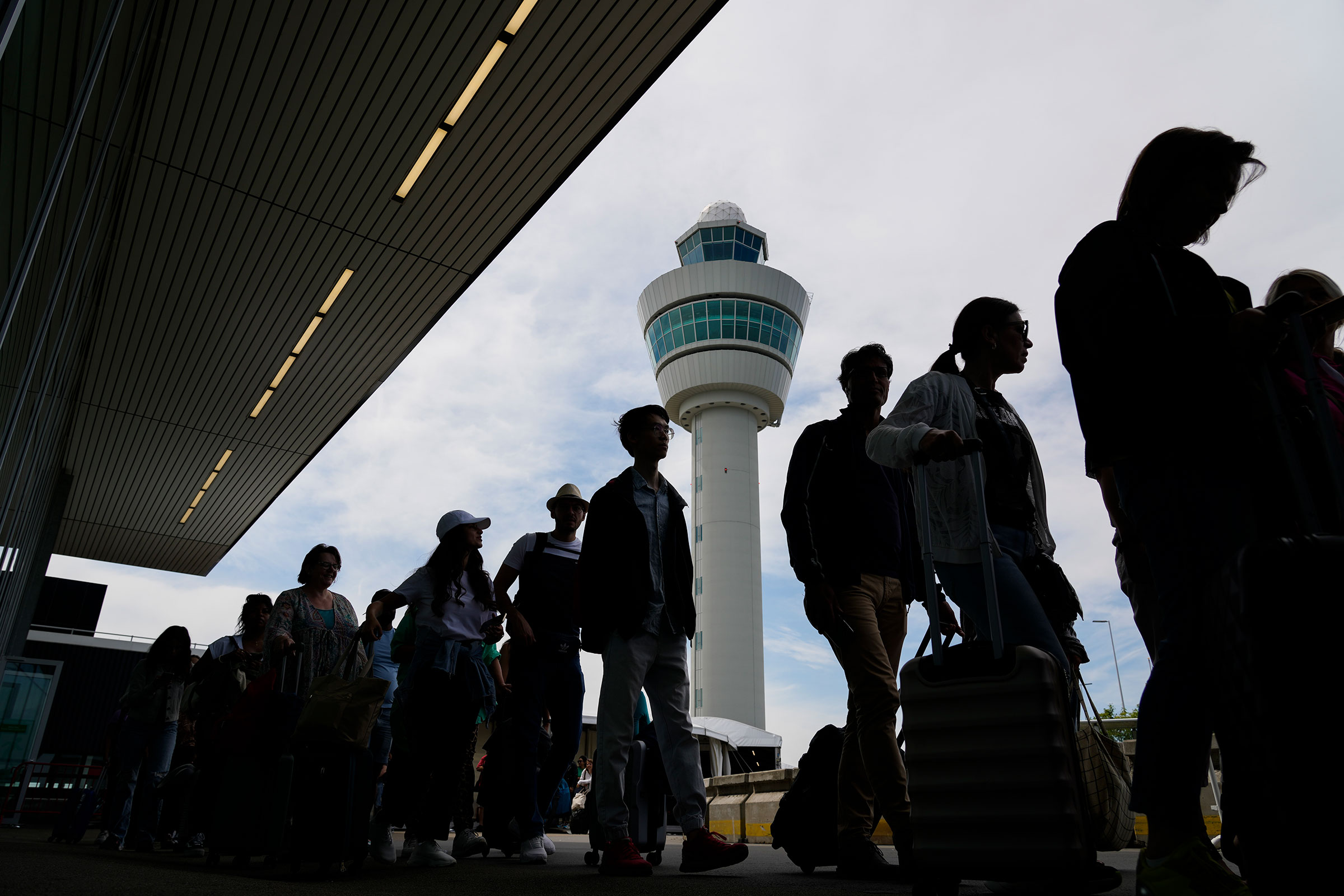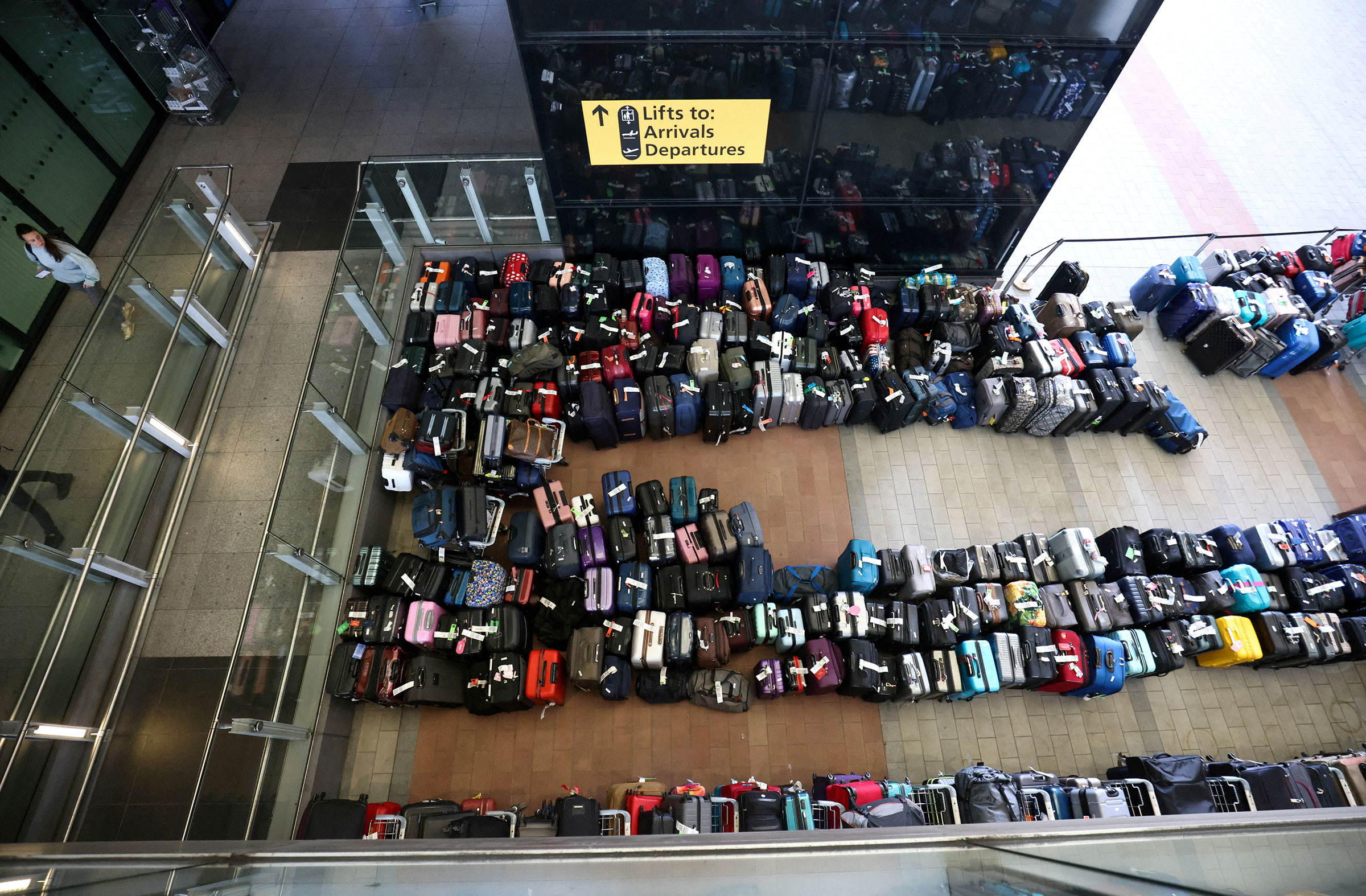One morning in early June, the security line at Copenhagen’s Kastrup airport snaked in long, grumpy arcs away from the scanners, back through the automated boarding pass machines to the end of the departures hall, down the stairs, and all the way back around to the 7-Eleven that stands at the terminal’s entry. “It was bad,” said one of the young workers in neon-yellow polo shirts, who had been hired recently to calm nerves and provide information to irritated and desperate travelers. There are a lot of them these days, even at an airport that is usually a model of smooth transit; Kastrup has been voted the world’s most efficient airport more than a dozen times. Pulling up a video of the seemingly endless queue on her phone, the worker added, “Normally we can bring people through the line if they’re going to miss their flight. But that day we were told we couldn’t because that was basically everybody.”
Across Europe and the United States, what was supposed to be the summer of travel’s joyful return has instead become a season of chaos. Soul-killingly long lines at check-in and security; hundreds of flights canceled every week because airlines can’t staff them; luggage that doesn’t show up for days. Much of this is pandemic-induced pain after the airline industry pretty much ground to a halt over the last two years, and is now struggling to catch up with surging demand. And as bad as it is for the passengers, airline and airport employees are suffering more: pilots, flight attendants, security personnel, baggage handlers, and even airport bus drivers report being overworked and stressed out like never before.
With the Fourth of July holiday weekend bearing down in the U.S. and widespread labor strikes underway, the situation doesn’t look like it will get fixed anytime soon. “Summer will still be rough,” says Umang Gupta, managing director of Alton Aviation Consultancy. “Airlines obviously want to take advantage of the fact that demand is coming back, but I don’t see that all these connected entities will be able to hire up by then.”
Read More: Flight Canceled or Delayed? Here’s What to Do
In June, it was taking four hours to get through security at Dusseldorf airport, while just last week at Amsterdam’s Schiphol, the line for security stretched out the terminal, through a tent set up by the side of the road, and back into the building. A technical error at Heathrow on the weekend of June 18-19 resulted in a “baggage mountain” of unclaimed luggage that, 10 days later, has reportedly started to stink.
That same month, Iberia airlines reported that since March, 15,000 passengers had missed their connections through Madrid’s Barajas airport. On several occasions in the last two months, Heathrow and Gatwick in London have both asked airlines to cap their daily number of flights. EasyJet has canceled 40 flights a day in June, or roughly 1,700 for the month; British Airways has taken 8,000 off its March-October schedule; and a random perusal of flight tracker flightaware.com shows United, KLM, American, Delta, and Lufthansa all currently canceling dozens each day.

It all stems from a combination of staff shortages and rebounding travel. Although total passenger numbers are still well below their 2019 levels globally, in March, the number of people flying European airlines skyrocketed 425% over the previous year and 228% on North American ones. Individual airports have experienced similar patterns: in May, 5.9 million more passengers flew through Paris airports, 4.1 million more through Amsterdam, and 3.4 million more through Frankfurt than in the same period the previous year. “Passenger numbers are higher now than at any time since the start of the pandemic—and growing,” says Sarah Fairley, senior press officer at Heathrow Airport, in a written statement. “We have faced 40 years of growth in just four months and that has put the entire aviation industry under pressure.”
Given the pent-up demand, shouldn’t airlines and airports have seen the surge coming? “Yes and no,” says Alton Aviation’s Gupta. “It seems obvious that, especially going into summer, demand was going to be high. But what we’re hearing universally from the airlines is that the rebound has been more dramatic than even the most optimistic projections predicted.”
Read More: Going on Vacation This Summer? Welcome to the ‘Revenge Travel’ Economy
At the same time, continued travel restrictions in some parts of the world and a number of false starts made some airlines wary of ramping up too quickly. “There were so many variables that it was impossible to predict when the uptick was going to happen,” adds Gupta.
The global aviation industry is still dealing with high numbers of staff absences from successive waves of COVID-19, as well as the fact it shed some 2.3 million employees—a full 21% of its workforce—during the pandemic. The shortages cut across all groups, from pilots and flight attendants to baggage handlers, security staff, air traffic controllers, and the attendants who help passengers board, and they require time to ramp up again. “There is an incredibly tight labor market across the whole of Europe—that’s not unique to aviation,” says Virgina Lee, director of media and communications for Airports Council International’s Europe branch. “But we have to also remember that when you’re recruiting people to work inside an airport, they have to have a security clearance. It’s not like recruiting for a supermarket.”
Obtaining clearances can take up to 16 weeks in some countries—on top of the time it takes to find candidates and train new employees. “In order to be fully staffed today, you would have had to start that process in the middle of December,” says Lee. “When we were, if you remember, at the peak of Omicron and indeed the peak of uncertainty about travel restrictions.”
At the best of times, an airport is a well-oiled machine, where the infrastructure’s staff combines with airlines’ and third-party providers to keep travel running smoothly. But that same interdependence helps explain why, even when an airport manages to address one disruption, others keep popping up. At Copenhagen’s Kastrup airport, for example, the administration decided to beef up its security staff back in November while air travel in Europe was still relatively moribund. “It cost a lot of money to hire people we didn’t immediately need at the time,” says Lise Agerley Kürstein, Copenhagen airport’s head of communication. “But our CEO took the decision so we would be ready for summer holidays.”

They didn’t quite get there, but with 330 hires since January, the security staff is almost back to its pre-pandemic level, and the snaking lines of late May and early June have mostly given way to “normal” wait times, Agerly Kürstein says. But security, she acknowledges, is only one component of the disruptions. “The airlines, the third-party companies, they’re all having problems getting employees too, and that makes it difficult for everyone. How do you build up a whole airport again?”
Some of those who once worked in airports have left for better paying, less difficult, or more stable careers. Workloads have increased dramatically for those who have stayed in the industry—which could lead to further departures. “When we started getting into the spring, the airlines were like, there’s the demand, let’s make it work,” says a flight attendant for a major U.S. carrier that flies to Europe. (She requested anonymity because she was not authorized by the airline to speak.) “But we just don’t have the people. On any day, I can look on our app and see that we’re down 70 people, and that’s just flight attendants from one base.”
Read More: Can Barcelona Fix Its Love-Hate Relationship With Tourists After the Pandemic?
As a result, she and her fellow airline employees are working much longer hours in much more tense conditions. With so many flights being canceled because of staff shortages, those that do fly are frequently re-routed, which means that crews can’t predict when they’ll get home, or even where they’ll be spending the night. In the past, cabin crews worked no more than four flights a day, but now five is not uncommon. And layovers have become shorter—so short, the same flight attendant tells TIME, that they frequently don’t have time to sprint across the terminal to find the one eatery still open (many airport concessions remain closed because of staffing problems as well). “We’re just exhausted,” she adds. “This job is not what I signed up [for] all those years ago. There’s no fun in it because the passengers are stressed. And when the passengers are stressed that stresses us.”
It’s that kind of stress and exhaustion—and in the case of at least one airline, British Airways, the COVID-19-era salary reductions that have yet to be annulled— that helps explain the labor strikes posing a new wave of challenges for airports. On June 21, 1,300 Southwest Airlines pilots picketed the company; on June 30, Delta pilots did the same in Atlanta and other airline hubs. On the same day, ground crews at Paris Charles de Gaulle initiated a four-day strike, which caused the airport to cancel 10% of its flights; while for Ryanair flight crews in Spain, it was day four of a six-day strike. Check-in staff and ground crews for British Airways have also approved labor actions for sometime this summer.
“It’s not necessarily about their compensation, although if I were in their shoes, I would probably be demanding more too,” says Alton Aviation Consultancy’s Gupta. “It’s because the amount of work has gone up so much. Among pilots in the U.S., I keep hearing, ‘I’ve never worked this much in my life; I’ve never done this much flying in a year.’ And it’s not just pilots: it’s security staff, it’s baggage handlers, it’s all the contracted workers.”
SAS airlines, which has one of its hubs at Copenhagen’s Kastrup, is facing a potential strike of its own next week, which means the airport’s recent, relative calm may soon dissipate again.
At the start of this week, Martin Lindblom, a 39-year-old visual artist on his way to Amsterdam from Copenhagen waited to pass through security next to large posters that pleaded for passengers’ patience. Expecting the worst, he had checked in online and arrived at the airport two hours early, but was pleasantly surprised to find the line moving quickly. Still, he wasn’t taking any chances. Noting that he would have to fly out of Amsterdam Schiphol, one of the most troubled airports, on his way home, he had resigned himself to a long day for his eventual return. “For that one, I’m getting to the airport six hours ahead of time.”
More Must-Reads from TIME
- Why Trump’s Message Worked on Latino Men
- What Trump’s Win Could Mean for Housing
- The 100 Must-Read Books of 2024
- Sleep Doctors Share the 1 Tip That’s Changed Their Lives
- Column: Let’s Bring Back Romance
- What It’s Like to Have Long COVID As a Kid
- FX’s Say Nothing Is the Must-Watch Political Thriller of 2024
- Merle Bombardieri Is Helping People Make the Baby Decision
Contact us at letters@time.com